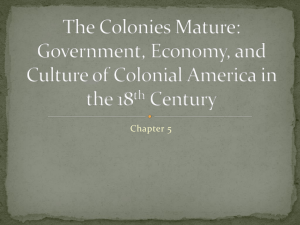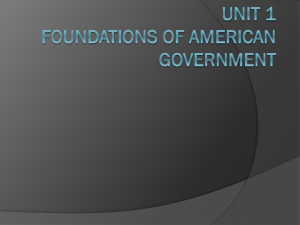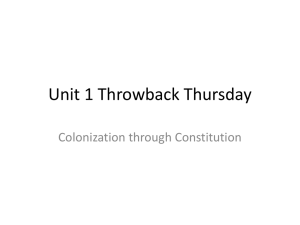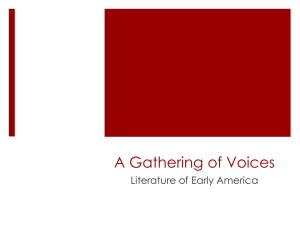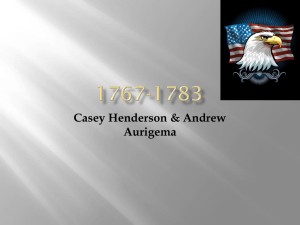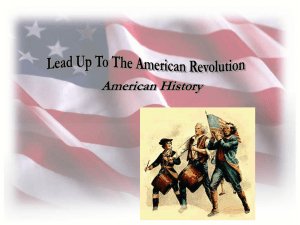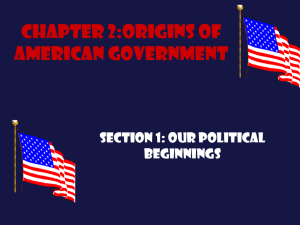Chapter 1 - Victory High School
advertisement
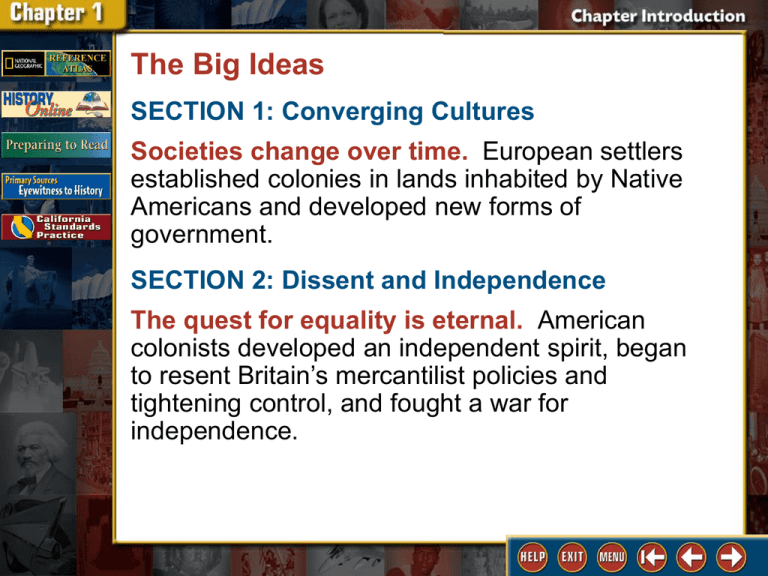
The Big Ideas SECTION 1: Converging Cultures Societies change over time. European settlers established colonies in lands inhabited by Native Americans and developed new forms of government. SECTION 2: Dissent and Independence The quest for equality is eternal. American colonists developed an independent spirit, began to resent Britain’s mercantilist policies and tightening control, and fought a war for independence. The Big Ideas SECTION 3: The Constitution A written contract between the people and their government can preserve natural rights and allow for change over time. When the Articles of Confederation proved to be too weak, Americans crafted a new constitution based on compromise and flexibility. In this section, you will discover how societies in North and Middle America changed over time and how European colonies developed. • Native Americans adapted to their environments and developed diverse cultures. (p. 99) • European countries began to explore the world and established colonies in the Americas. (p. 101) • The French and English settled in North America, and English colonists began their own local governments. (p. 102) • As English settlements grew, colonists developed different forms of government to regulate life in their communities. (p. 103) • The different colonies created new social structures that were more open than those of aristocratic Europe. (p. 107) civilization, joint-stock company, Pilgrim, subsistence farming, proprietary colony, indentured servant, triangular trade, slave code culture, immigrate, hierarchy Christopher Columbus, William Penn Jamestown I. The Earliest Americans (pages 97–100) A. Scientists are unsure when the first people came to America, but scientific speculation points to between 15,000 and 30,000 years ago. These newcomers to America were probably nomads, people who continually move from place to place. B. When Native Americans learned how to plant and raise crops, permanent villages were established. Eventually, civilizations emerged. A civilization is a highly organized society marked by advanced knowledge. I. The Earliest Americans (pages 97–100) C. Anthropologists believe the Olmec culture was the first civilization in America. The culture began between 1500 and 1200 B.C. in what is today southern Mexico. The Maya and the Aztec later developed civilizations in Central America. Anthropologists believe that the agricultural technology of Mesoamerica spread into the American Southwest and beyond, changing many North American nomads into farmers. I. The Earliest Americans (pages 97–100) D. At the same time that the Olmec civilization began, cultures were developing in the eastern woodlands of North America. The Hopewell built huge geometric earthworks. The Mississippians built Cahokia, one of the largest cities ever built by early Americans. E. Native Americans throughout North America developed varied cultures based on their adaptations to their particular environment. II. European Explorations (pages 101–102) A. Europeans emerged from the Middle Ages with an interest in finding a more direct trade route to Asia. In the late 1400s the Portuguese took the lead. B. Christopher Columbus, an Italian, was convinced that he could reach Asia by sailing west. In 1492 Columbus, backed by Spanish monarchs, set sail with three ships and landed on present-day San Salvador Island. II. European Explorations (pages 101–102) C. Though the Vikings were the first to reach the Americas, Columbus launched the ongoing exploration and settlement of the continents. D. In 1494 the Treaty of Tordesillas, which gave Spain the right to most of the newly discovered lands, opened the door to Spanish explorers. II. European Explorations (pages 101–102) E. With superior firepower, the Spanish were able to conquer local peoples and establish settlements across a wide swath of the Americas. Besides farming, ranching, and mining, the Spanish were interested in spreading the Catholic faith to the Native Americans. Spanish armor and helmet II. European Explorations (pages 101–102) F. The arrival of Europeans in the Americas had both positive and negative consequences. Benefits of this cultural intermingling between the Americas and Europe include the exchange of new foods, farming methods, inventions, and technology. However, military conquests and exposure to diseases that they had no immunity to devastated the Native American population. III. Early French and English Settlement (pages 102–103) A. By the 1600s the French and English had established colonies in the eastern part of North America. B. New France, centered in Quebec, was founded to foster the fur trade. French explorers Louis Joliet, Jacques Marquette, and Rene-Robert Cavalier de la Salle claimed the Mississippi River region, named Louisiana, for France. They began importing enslaved Africans to grow sugar, rice, and tobacco. III. Early French and English Settlement (pages 102–103) C. A joint-stock company, or group of investors who pool their money to support big projects, funded Jamestown, the first English settlement in the New World. Colonies were considered vital sources of raw materials and markets for English goods. Captain John Smith and a painting of Jamestown. III. Early French and English Settlement (pages 102–103) D. By 1619 English colonists in Virginia had formed a self-governing body called the House of Burgesses. E. Some Puritans, called Separatists, were being persecuted by King James. In 1620 one group of Separatists, who became known as Pilgrims, set sail for America on the Mayflower and settled off the coast of Cape Cod. III. Early French and English Settlement (pages 102–103) F. The Pilgrims drew up a plan for self-government called the Mayflower Compact. G. More Puritans moved to the Massachusetts Bay Colony and set up a representative government heavily influenced by religion. Signing of the Mayflower Compact by Tompkins Matteson IV. The Thirteen Colonies (pages 103–107) A. The strict, religious-based government of the Massachusetts Bay Colony led to dissenters who started new colonies. After being banished from Massachusetts, Roger Williams and Anne Hutchinson each founded settlements that would become Rhode Island and the Plymouth Plantation. B. Total separation of church and state was a key feature of Rhode Island, Connecticut, and New Hampshire. IV. The Thirteen Colonies (pages 103–107) C. In New England, Puritans valued religious devotion, hard work, obedience to strict rules, and a form of self-government that arose from town meetings. D. New England farmers, plagued by poor and rocky soil, practiced subsistence farming, or raising only enough food to feed their families. Fishing, whaling, and the lumber industry— which included shipbuilding—allowed the New England colonies to prosper. IV. The Thirteen Colonies (pages 103–107) E. Although the colonists’ relations with Native Americans were largely peaceful, tensions arising from colonial demands that Native Americans follow English laws and customs led to King Philip’s War. The colonists won the war in 1678. Afterwards, very few Native Americans were left in New England. F. In the Middle Colonies the Dutch established New Netherland. England’s King Charles II seized New Netherland, which was renamed New York. IV. The Thirteen Colonies (pages 103–107) G. New Jersey, once part of New Netherland, offered land grants, religious freedom, and the right to a legislative assembly. H. In Pennsylvania, founded by William Penn, settlers who had been persecuted because of their religion found a safe haven. IV. The Thirteen Colonies (pages 103–107) I. The Middle Colonies contained fertile farmland which produced bumper crops, the most important of which was wheat. In the 1700s a population explosion in Europe led to a doubling of wheat prices, a surge of prosperity, a new wave of immigrants, and investment in new businesses in the Middle Colonies. This picture of Bethlehem, Pennsylvania is typical of many towns in the Middle Colonies. IV. The Thirteen Colonies (pages 103–107) J. A proprietary colony, such as Maryland, was owned by an individual who could govern in any manner he saw fit. Maryland, governed by George Calvert, also known as Lord Baltimore, was founded as a refuge for Catholics. In 1649, Maryland passed the Toleration Act, which granted religious toleration to all Christians. K. In 1663 King Charles II granted his friends and political allies land that would become North Carolina and South Carolina. Easier to reach, South Carolina grew more rapidly. IV. The Thirteen Colonies (pages 103–107) L. Georgia was established as a refuge for debtors, an idea put forth by James Oglethorpe, a member of the English Parliament. Georgia also served as a barrier to northern expansion by the Spanish in Florida. M. The Southern economy was based on agriculture. To get the workers, colonists imported enslaved Africans. They also contracted with indentured servants, or immigrants who agreed to work for a colonist for a set amount of time in exchange for passage to America, food, clothing, and shelter. IV. The Thirteen Colonies (pages 103–107) N. Southern society was divided into wealthy plantation owners, subsistence farmers, and tenant farmers—landless farmers who rented land to work from wealthy landowners. O. Sir William Berkeley, the governor of Virginia, dominated Virginia’s society in the 1660s. He restricted the vote to people who owned property, in effect cutting the number of voters in Virginia in half. He also exempted himself and his councilors from taxation. These actions angered backcountry and tenant farmers. IV. The Thirteen Colonies (pages 103–107) P. Some backcountry farmers wanted to expand their landholdings. However, the only land left was located in territory that Native Americans claimed. The wealthy planters had little interest in the concerns of backcountry farmers and were unwilling to risk conflict with the Native Americans. As a result, they opposed expanding the colony. Q. In 1675 war erupted between backcountry settlers and the Native Americans of the region. Governor Berkeley’s refusal to sanction military action against the Native Americans angered the backcountry farmers. IV. The Thirteen Colonies (pages 103–107) R. In 1676 backcountry farmers, under the leadership of a wealthy planter named Nathanial Bacon, organized their own militia and attacked the Native Americans. The assembly authorized Bacon to raise troops to attack the Native Americans, and it also restored the vote to all free men. IV. The Thirteen Colonies (pages 103–107) S. Bacon was not satisfied with the reforms, and in 1676 he and several hundred armed followers returned to Jamestown, charged Berkeley with corruption, and seized power. Berkeley fled Jamestown and raised his own army. In September 1676, the two armies fought for control of Jamestown, and the town burned down. Bacon’s Rebellion ended when Bacon became sick and died. IV. The Thirteen Colonies (pages 103–107) T. Bacon’s Rebellion illustrated to Virginia’s wealthy planters that backcountry farmers needed to have land available to them. It also increased the trend of purchasing enslaved Africans instead of indentured servants for working the plantations. At the same time, the English government adopted policies that encouraged slavery. Earlier, in 1672, it had granted a charter to an English company—the Royal African Company—to engage in the slave trade. V. A Diverse Society (pages 107–108) A. New England produced few goods that England wanted in exchange for the goods they wanted. B. To compete, colonial merchants developed a triangular trade, exchanging goods between the colonies, England, Caribbean sugar planters, and Africa. This trade led to increased colonial wealth, business investment, and the growth of cities. V. A Diverse Society (pages 107–108) C. The increase in trade in the colonies led to the development of colonial America’s first cities. A new society with distinct social classes developed in these cities. At the top were wealthy merchants; at the bottom, indentured servants and enslaved Africans. They are all dead now. Painting of the Port of Boston V. A Diverse Society (pages 107–108) D. Enslaved Africans arrived in the colonies as early as 1619. By 1775 they comprised about 20 percent of the colonial population. Laws called slave codes denied enslaved Africans basic citizenship rights including the right to own property, the right to an education, the right to meet in large groups, and the right to move about freely. V. A Diverse Society (pages 107–108) E. Between 1700 and 1775, hundreds of thousands of free Europeans settled in the colonies. F. Women and Jews did not have equal citizenship rights in the colonies. For example, neither group could vote or hold public office. • The colonists learned about the ideas of natural rights and justified revolutions, while British mercantilist policies limited their freedom. (p. 110) • The ideas of the Enlightenment and the Great Awakening made the colonists question their role as subjects of the English monarch. (p. 111) • Unpopular British laws and taxes led to colonial protests and violence. (p. 113) • When Britain introduced new laws to assert its authority, the colonists decided to declare their independence. (p. 114) • With the help of their allies, the Americans defeated the British in the Revolutionary War. (p. 117) mercantilism, Enlightenment, Great Awakening, customs duty, committee of correspondence, minuteman logic, exports, communicate John Locke, Stamp Act, Townshend Acts, Intolerable Acts, George Washington, Declaration of Independence Lexington, Concord, Yorktown I. Mercantilism (pages 110–111) A. Mercantilism is a set of ideas about the world economy and how it works. Mercantilists believed that a country’s wealth was measured by the amount of gold and silver it possessed. They believed that having a greater number of exports than imports would result in more gold and silver flowing into the country. I. Mercantilism (pages 110–111) B. Mercantilists also believed that a country should establish colonies in order to be selfsufficient in raw materials. The home country would then sell its manufactured goods to the colonies. C. When King Charles II assumed the throne, he was determined to generate wealth by regulating trade in the American colonies. Parliament passed the Navigation Act of 1660, which required all goods imported or exported from the colonies to be transported on English ships. The act also listed specific raw materials that the colonies could sell only to England. The list included most of the products that were profitable for the colonies. I. Mercantilism (pages 110–111) D. Parliament passed another navigation act in 1663, the Staple Act. This law required all goods imported by the colonies to come through England. Merchants who were bringing goods to the colonies had to stop in England, pay taxes, and then ship the goods out on English ships. The practice generated money for England, but increased the prices of goods in the colonies. I. Mercantilism (pages 110–111) E. The Navigation Acts angered colonial merchants, who in most cases broke the new laws. English officials discovered that merchants in Massachusetts ignored the Navigation Acts and smuggled their goods to Europe, the Caribbean, and Africa. King Charles II responded to Massachusetts’ refusal to observe the laws by withdrawing the colony’s charter and making it a royal colony. I. Mercantilism (pages 110–111) F. King James II, who succeeded Charles to the throne, merged Plymouth and Rhode Island with Massachusetts to create a royal province called the Dominion of New England. Connecticut, New Jersey, and, later, New York also became part of the Dominion. Sir Edmund Andros was appointed the first governor. His harsh rule angered nearly everyone in New England. I. Mercantilism (pages 110–111) G. Many people in England opposed King James II. He disregarded parliament, revoked town charters, and openly practiced Catholicism. H. When James’s son was born, Parliament acted to prevent a Catholic dynasty by inviting James’s Protestant daughter and her husband, William of Orange, to claim the throne. James fled, and William and Mary became the new rulers. This bloodless change of power became known as the Glorious Revolution. I. Mercantilism (pages 110–111) I. Parliament established the English Bill of Rights, which limited the powers of the monarchy and listed the rights that Parliament and English citizens were guaranteed. The English Bill of Rights would become incorporated into the American Bill of Rights. I. Mercantilism (pages 110–111) J. After King James II was dethroned, an uprising occurred in Boston, and Governor Andros was ousted. The new monarchs reinstated Rhode Island’s and Connecticut’s previous forms of government. Massachusetts received a new charter, which combined the Massachusetts Bay Colony, Plymouth Colony, and Maine into the royal colony of Massachusetts. The colonists elected an assembly, but the king appointed the colony’s governor. Those who owned property could vote, but they did not have to be members of a Puritan congregation. I. Mercantilism (pages 110–111) K. John Locke, a political philosopher, wrote a book entitled Two Treatises of Government. In the book, Locke asserted that all people were born with natural rights, including the right to life, liberty, and property. Locke believed that people created governments to protect their rights. In return, the people agreed to obey the government’s laws. Locke also asserted that if a government violated people’s rights, the people were justified in changing the government. Locke’s theory greatly influenced the American colonists. II. The Enlightenment and the Great Awakening (pages 111–112) A. The Enlightenment was a cultural movement that arose in Europe in the 1600s and 1700s. Enlightenment thinkers asserted that the physical world and human nature operated in an orderly way according to natural laws. Through logic, these laws could be deciphered. II. The Enlightenment and the Great Awakening (pages 111–112) B. John Locke was an influential Enlightenment writer. He argued that all people had rights and that society could be improved through experience and education. C. Jean Jacques Rousseau argued that government should be formed by the consent of the people in his The Social Contract. D. In The Spirit of the Laws, Baron Montesquieu argued that government power should be separated into three branches, which would provide checks and balances against an all-powerful government. II. The Enlightenment and the Great Awakening (pages 111–112) E. Many American colonists in the 1700s went to revivals that stressed piety and emotional union with God. This revival of religious feelings became known as the Great Awakening. Jonathan Edwards and George Whitefield were two important preachers of the Great Awakening. II. The Enlightenment and the Great Awakening (pages 111–112) F. The Great Awakening had a great impact on the Southern Colonies, and was especially appealing to backcountry and tenant farmers and to enslaved Africans, thousands of whom had joined Baptist congregations. G. The Enlightenment and the Great Awakening emphasized individualism and helped lead the American colonists toward independence. III. Growing Rebelliousness (pages 113–114) A. In 1754, France and Great Britain went to war over control of the Ohio River Valley. It was called the French and Indian War in North America, and the Seven Years War in Europe. B. Great Britain won, and the 1763 Treaty of Paris made Great Britain the dominant power in North America. C. The 1763 British victory caused an enormous British debt. Britain looked to its colonies to help pay for the war and the cost of defending its new territories. III. Growing Rebelliousness (pages 113–114) D. The British government did not want to pay for another war, so it issued the Royal Proclamation of 1763 that limited western settlement. The proclamation angered many farmers and land speculators. E. Merchants smuggled goods in and out of America to avoid customs duties, or taxes paid on imports and exports. To bring in revenue, Great Britain introduced the Sugar Act in the colonies. This act raised tax rates for raw sugar and molasses imported from foreign colonies. It placed new taxes on silk, wine, coffee, and indigo. III. Growing Rebelliousness (pages 113–114) F. The Stamp Act of 1765, the first direct tax placed on the colonists, enraged the colonists. G. Groups calling themselves the Sons of Liberty organized mass meetings and demonstrations against the stamp tax. Representatives from nine of the colonies formed the Stamp Act Congress to petition the King for repeal of the Stamp Act. III. Growing Rebelliousness (pages 113–114) H. When the Stamp Act took effect, the colonists ignored it. A movement began to boycott British goods. The protests led to the Stamp Act being repealed in 1766. I. In 1767 the British attempted to raise funds by passing the Townshend Acts, which placed new customs duties on glass, lead, paper, paint, and tea imported into the colonies. J. When leaders in Massachusetts and Virginia challenged Britain’s right to tax them, Parliament dissolved their assemblies. Colonial merchants united in a boycott against British goods. III. Growing Rebelliousness (pages 113–114) K. On March 5, 1770, British troops fired into a crowd of colonists in Boston. Aman of African and Native American descent was the first colonist to die in what became known as the Boston Massacre. The British were viewed as tyrants who were killing people standing up for their rights. In response, Britain repealed the Townshend Acts, leaving only one tax on tea to uphold its right to tax the colonies. III. Growing Rebelliousness (pages 113–114) IV. The Road to War (pages 114–117) A. Shortly after the repeal of the Townshend Acts in 1770, the British government introduced several new policies that angered American colonists. B. Britain sent customs ships to patrol North American waters in order to intercept smugglers. In 1772 the British customs ship, the Gaspee, was seized by colonists and burned. The British took suspects to England for trial. Colonists felt this was a violation of their right to a trial by a jury of their peers. IV. The Road to War (pages 114–117) C. Thomas Jefferson thought each colony should create a committee of correspondence to communicate with other colonies about British activity. This helped unify the colonies and coordinate plans for resistance. IV. The Road to War (pages 114–117) D. To assist the British East India Company with tea sales, Parliament passed the Tea Act of 1773, which made East India’s tea cheaper than smuggled Dutch tea. American merchants feared it was the first step by the British to force them out of business. In December 1773, tea ships from the East India Company arrived in Boston Harbor. Colonists boarded the ship and dumped the tea into the harbor. This became known as the Boston Tea Party. IV. The Road to War (pages 114–117) E. The Boston Tea Party led the British to pass four new laws called the Coercive Acts. These acts were an attempt to stop colonial challenges of British authority. The Coercive Acts violated several English rights, including the right to trial by a jury of one’s peers and the right not to have troops quartered in one’s home. General Thomas Gage was appointed governor of Massachusetts to enforce the new acts. IV. The Road to War (pages 114–117) F. The Quebec Act gave more territory to Quebec and stated that a governor and council appointed by the king would run Quebec. This further angered the colonists because if they moved west, they would be living in territory with no elected assembly. The Coercive Acts and the Quebec Act together became known as the Intolerable Acts. IV. The Road to War (pages 114–117) G. On September 5 the 55 delegates of the First Continental Congress decided to boycott British goods, and to hold a second Continental Congress if necessary. H. Massachusetts regrouped, naming John Hancock as their leader. The town of Concord created a special unit of minutemen, trained and ready to fight the British in a minute’s warning. IV. The Road to War (pages 114–117) I. The American Revolution was not just a war between Americans and British but also a war between Loyalists and Patriots. Americans who remained loyal to the king and felt British laws should be upheld were called Loyalists, or Tories. The group included government officials, prominent merchants, landowners, and a few farmers. The Patriots, or Whigs, thought the British were tyrants. Patriots included artisans, farmers, merchants, planters, lawyers, and urban workers. There was a group of Americans in the middle who did not support either side. IV. The Road to War (pages 114–117) J. On April 18, 1775, British General Gage and his troops set out to seize the militia’s supply depot at Concord. To get there, they had to pass through Lexington. Patriots were sent to warn the people that the British were coming. When the British arrived in Lexington, about 70 minutemen were waiting for them. The British fired at the minutemen, killing 8 and wounding 10. K. The British moved on to Concord where they found 400 colonial militia waiting for them. They forced the British to retreat. IV. The Road to War (pages 114–117) L. After the battles at Lexington and Concord, the Second Continental Congress met in Philadelphia to address the issue of defense. The Congress voted to adopt the militia army around Boston and name it the Continental Army. On June 15, 1775, Congress appointed George Washington to head the Continental Army. M. The Battle of Bunker Hill resulted in turning back two British advances, and the colonial militia only retreated due to a lack of ammunition. It was a huge boost to American confidence that the untrained colonials could stand up to the feared British forces. IV. The Road to War (pages 114–117) N. In July 1775, the Continental Congress sent a document known as the Olive Branch Petition to the king. It stated that the colonies were still loyal to King George III and asked the king to call off the army while a compromise could be made. At the same time, radicals in Congress had ordered an attack on the British troops in Quebec. This convinced the British that there was no hope of reconciliation. King George refused to look at the Olive Branch Petition. IV. The Road to War (pages 114–117) O. As the fighting spread, more colonists became Patriots. In January 1776 the persuasive pamphlet called Common Sense, by Thomas Paine, caused many colonists to call for independence from Britain. On July 4, 1776, a committee of Patriot leaders submitted a document written by Thomas Jefferson. The full Continental Congress issued this Declaration of Independence. The American Revolution had begun. V. Fighting for Independence (pages 117–119) A. The Continental Army faced disadvantages against the British Army in size, funding, discipline, and experience. However, they did have some advantages, including fighting on home ground, unconventional fighting tactics, and an overextended British army. B. In the Northern Campaign, General Howe quickly seized New York City before heading to Philadelphia. Washington countered with a surprise attack before both sides camped for the winter. V. Fighting for Independence (pages 117–119) C. In 1777 British General Howe’s troops defeated Washington at the Battle of Brandywine Creek and captured Philadelphia. However, the Continental Congress, which he had hoped to capture, had escaped. Howe had failed to destroy the Continental Army. D. General Burgoyne surrendered at Saratoga, and over 5,000 British troops were taken prisoner. The American victory was a turning point because it improved American morale and convinced France to send troops to the American cause. V. Fighting for Independence (pages 117–119) E. In February 1778 Americans signed two treaties with France. As a result of the treaties, France became the first country to recognize the United States as an independent nation, and the United States and France formed an alliance. F. After losing in Saratoga, the British changed their strategy. They attacked in the South where they hoped to find more Loyalist support. V. Fighting for Independence (pages 117–119) G. The British at first dominated in the South. In 1778 they captured Savannah, Georgia, and General Charles Cornwallis forced the surrender of 5,500 American troops in Charles Town, South Carolina, in 1780. H. Americans had already won in the West and turned the tides on the British in the South by late 1780. I. In Yorktown, Virginia, in the fall of 1781, General Cornwallis became trapped by Washington’s land forces and the French navy. On October 18, 1781, Cornwallis surrendered. V. Fighting for Independence (pages 117–119) J. After learning of the surrender, Parliament voted to end the war. The Treaty of Paris was signed on September 3, 1783. In the treaty, the British recognized the United States as a new nation with the Mississippi River as its western border. Britain kept Canada but gave Florida back to Spain in a separate treaty. The French received back their former colonies in Africa and the Caribbean. In the previous section, you learned how the American colonists defeated the British in the Revolutionary War. In this section, you will discover how America’s founders authored the United States Constitution. • The states created constitutions that gave people more rights, but the national framework could not address all the problems of the new nation. (p. 125) • American leaders created a new constitution based on compromise. (p. 126) • The promise of a Bill of Rights guaranteed the ratification of the Constitution. (p. 129) republic, recession, popular sovereignty, federalism, separation of powers, checks and balances, veto, amendment, ratification framework, interpret, revise Articles of Confederation, Northwest Ordinance, Shays’s Rebellion, Constitutional Convention, Great Compromise, Three-Fifths Compromise, Federalists, Antifederalists I. The Young Nation (pages 125–126) A. In the new United States of America, a republic was formed. In a republic power resides with a body of citizens who have the right to vote. Elected leaders must govern according to a constitution. B. Many states already had constitutions that embodied ideas such as separation of powers and a list of rights guaranteeing freedoms. C. The Virginia Statute of Religious Freedom, passed in 1786, reflected the concern for individual liberty. It said that Virginia no longer had an official church. I. The Young Nation (pages 125–126) D. Voting and most other political rights were extended to white males only. E. After the Revolution, women made some advances. They could more easily obtain a divorce. They also gained greater access to education. F. Thousands of enslaved African Americans obtained their freedom during and after the war. Many American leaders felt that enslaving people conflicted with the new views of liberty and equality. I. The Young Nation (pages 125–126) G. On March 2, 1781, American leaders created the Articles of Confederation which loosely organized the states under one governing body, the Confederation Congress. H. Under the Articles of Confederation, Congress could negotiate with other nations, raise armies, and declare war, but could not regulate trade or impose taxes. I. The Young Nation (pages 125–126) I. The Young Nation (pages 125–126) I. To raise money, Congress created the Northwest Ordinance of 1787, a plan for how states would be created in the lands west of the Appalachians and north of the Ohio River—the Northwest Territory. J. Because the Congress lacked the power to regulate trade and to tax, the new country fell into a recession, or economic slowdown. Congress could not pay its expenses or war debts, or stop the states from issuing their own money, which further damaged the economy. I. The Young Nation (pages 125–126) K. Poor farmers were hit hard by the recession. In 1787 a bankrupt Massachusetts farmer named Daniel Shays led 1,200 followers in a protest of new taxes. Shay’s Rebellion illustrated the weaknesses of the Confederation Congress. People began to argue for a stronger central government. II. A New Constitution (pages 126–129) A. At the Constitutional Convention in 1787, 55 delegates went to Philadelphia to revise the Articles of Confederation. They threw them out and wrote a new framework of government. The Philadelphia Statehouse, site of the Constitutional Convention II. A New Constitution (pages 126–129) B. The convention appointed a special committee to resolve differences between the large and small states. The committee worked out the Great Compromise. It proposed that in the House of Representatives, the states would be represented according to the size of their populations. The Senate would have equal representation. The voters in each state would elect the House of Representatives. The state legislatures would choose the senators. II. A New Constitution (pages 126–129) C. The Three-Fifths Compromise was a plan for counting enslaved people in a state. Every five enslaved people in a state would count as three free persons for determining both representation and taxes. II. A New Constitution (pages 126–129) D. The Constitution was based on the principle of popular sovereignty, or rule by the people. The Constitution created a system of government called federalism. This divided the government between the federal, or national, government and the state governments. The Constitution provided for a separation of powers among the three branches of government. The legislative branch makes the laws. It is made up of the two houses of Congress. The executive branch enforces the laws. It is headed by a president. The judicial branch interprets federal laws. It is made up of a system of federal courts. II. A New Constitution (pages 126–129) E. The Constitution also provides for a system of checks and balances to prevent any one of the three branches from becoming too powerful. The powers of the president include proposing legislation, appointing judges, putting down rebellions, and the ability to veto, or reject, legislation. The powers of the legislative branch include the ability to override the veto with a two-thirds vote in both houses. The Senate approves or rejects presidential appointments. Congress can impeach, or formally accuse of misconduct, and then remove the president or any high official in the executive or judicial branch if convicted during trial. The judicial branch would hear all cases arising under federal laws and the Constitution. II. A New Constitution (pages 126–129) F. The Constitution has a system for making amendments, or changes to the Constitution. There is a two-step process for amending the Constitution—proposal and ratification. New amendments can be proposed by a vote of two-thirds of the members of both houses of Congress, or two-thirds of the states could call a constitutional convention to propose new amendments. A proposed amendment must be ratified by three-fourths of the state legislatures or by conventions in three-fourths of the states. III. The Fight for Ratification (pages 129–131) A. On September 28, 1787, the Confederation Congress submitted the Constitution to the states for ratification, or approval. Nine of the 13 states had to approve it. B. People who supported the Constitution were Federalists. Many Federalists were interested in protecting their property and regulating trade. C. Constitution opponents were called Antifederalists. They wanted a national government but were concerned about which would be supreme—the state governments or the national government. III. The Fight for Ratification (pages 129–131) D. Federalists organized their arguments in a collection of 85 essays called The Federalist. E. In order to get the Constitution ratified in Massachusetts, Federalists promised to add a bill of rights to the Constitution once it was ratified and to support an amendment that would reserve for the states all powers not specifically granted to the federal government. F. The Bill of Rights, or the first ten amendments to the Constitution, guaranteed the freedoms of speech, press, and religion; protection from unreasonable searches and seizures; and the right to a trial by jury. III. The Fight for Ratification (pages 129–131) G. In June of 1788, New Hampshire became the ninth state to ratify the Constitution. New York and Virginia had not ratified it, however, and many feared the new government would not succeed without their support. Gradually, all 13 states ratified the Constitution. H. George Washington was chosen as the first president under the new Constitution. Chapter Summary
